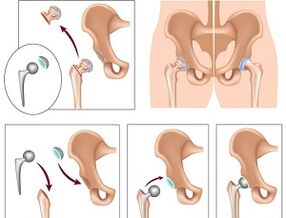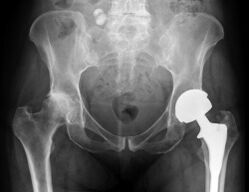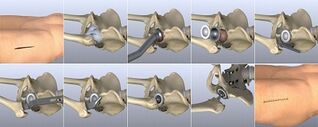
Coxarthrosis is a disease that affects the patient's hip joint. Treatment is long-term. Just a few decades ago, such a diagnosis was practically a sentence for a patient, who promised him: severe exhausting pains, a gradual decrease in mobility, early disability.
But thanks to the most effective modern methods of treatment, it has become possible not only to stop the degenerative process, but even to completely cure coxarthrosis in the early stages.
Understanding the causes of the disease has given rise to the use of an integrated approach in therapy. Treatment of arthrosis of the hip joint can include both taking medications and methods of physiotherapy.
What is hip arthrosis
Arthrosis is a disease in which the normal structure of the cartilage tissue of the joints is disrupted. Unlike arthritis, the cause of the deformation is not an infectious inflammation of tissues, but a violation in metabolic processes.
Deforming arthrosis of the hip joint, with rare exceptions, is observed in patients over 40 years of age. The development of pathology is as follows:
- Metabolism is impaired. Cartilage has no blood vessels, so it is nourished by the adjacent muscle tissue. For various reasons, the synthesis of substances is disrupted.
- Due to insufficient nutrition, the cartilage begins to lose its elasticity. Over time, it becomes thinner. The interosseous lumen is significantly reduced. Arthrosis in the hip joint of grade 3 is characterized by the fact that the growths on the bone tissue rub against each other. Cartilage is practically absent.
- Loading on the bone, reducing the thickness of the cartilage contributes to the deformation of the bone tissue.

After the onset of degenerative changes, it may take years until the patient develops the third stage of the disease, but under unfavorable circumstances and non-observance of precautions, pathological changes can occur much faster.
How arthrosis manifests itself
Symptoms of arthrosis of the hip joint and their nature depends on the degree of development of the disease. The most common symptom is pain. It is because of the pain that patients most often turn to a doctor for qualified help. Moreover, the insidiousness of the disease is that at the early stage of degenerative changes, pain, as a rule, does not cause great inconvenience, is of a short-term nature and is often attributed to ordinary fatigue.
Delay leads to the fact that the most opportune moment to start treatment is missed, and to cure grade 2 hip arthrosis requires more time and effort. The chances of a successful prognosis still remain, provided that the therapy is prescribed correctly.
The symptoms of the disease are:
- Pain - can appear in the thigh, groin and in the joint itself. It is worthwhile to be wary if pain symptoms appear at rest. This indicates the need for an urgent visit to an arthrologist.
- Stiffness of movement, limping. It is observed after prolonged immobility of the leg, for example, after sleep.
- Over time, the diseased leg becomes shorter than the healthy one, muscle tissue atrophy is observed, which is palpable.
In the diagnosis of a disease, one cannot do without modern diagnostic studies. Thus, grade 1 hip arthrosis is diagnosed only with the help of X-ray, CT and MRI. The picture clearly shows changes and narrowing of the interosseous lumen.
Stages of hip arthrosis
After diagnosing a pathology, the patient is assigned a code according to ICD 10. This is an international classification of diseases, which is revised every 10 years.
Thanks to the assigned code, not only statistics are collected. Therapies that have yielded the most tangible results can be selected. Thanks to international cooperation, the medical treatment of hip arthrosis has improved significantly over time.

In world practice, it is recognized that arthrosis of the hip joint has three stages or stages of development. Each of them has its own symptomatology. Namely:
- First stage.Pain sensations arise only against the background of excessive exertion: running, exercise, exercise, and so on. The pain is concentrated mainly in the joint area. The pain usually goes away on its own after some rest. In this case, the mobility of the leg remains in full, muscle strength is not limited. First-degree arthrosis can only be diagnosed with X-ray or tomography. The image clearly shows small deformations of the bone tissue, which do not go beyond the so-called articular lip. The joint gap is slightly narrowed, usually in uneven areas.
- Second stage.Characterized by migratory pains that begin to spread to the groin, thigh. May occur spontaneously during rest. Pain in arthrosis of the hip joint in the second stage does not go away on its own and requires the patient to take anesthetics. The range of motion is impaired, and muscle tissue atrophy is observed. The image clearly shows bone growths and deformities of the femoral head. Perhaps the appearance of a cyst in the most loaded part of the thigh - the acetabulum. Diagnosis of arthrosis at the second stage is carried out quickly. Even with a cursory examination, pathological changes are obvious. X-rays or MRIs are done to see the extent of the deformity.
- Third stage.Pain begins to be chronic. It is possible to determine arthrosis even without a thorough examination. The patient cannot move without a cane, there is a tilt of the pelvis, which leads to a shortening of the leg. When moving, the patient has to tilt his torso on the damaged joint. As a result, this leads to even greater degenerative changes. The image shows extensive bone deformities. The joint gap is almost invisible.
Therapeutic treatment of deforming arthrosis of the hip joint is effective only at stages 1-2 of the disease. The third stage in the development of pathology often leads to the need for surgical intervention.
How to treat arthrosis in the hip joint
Regardless of what is used, gymnastics for arthrosis of the hip joint or taking medication, all approaches are based on six fundamental principles. Namely:
- Take the pain away.
- Provide normal nutrition to the cartilage tissue and restore it if possible.
- Improve blood flow to the affected area.
- Reduce stress on the joint.
- Strengthen atrophied muscles.
- Restore joint mobility.
To achieve all six goals, it is necessary to use complex therapy. So, for example, by prescribing injections into the joint, but without taking care of reducing the load on it, you can negate all the beneficial effects of chondroprotectors. It is not surprising that in world practice, from 2 to 10 different approaches are usually used simultaneously, depending on the patient's condition.
How to treat hip arthrosis

A comprehensive approach to the treatment of the hip joint provides better results than using only one therapeutic agent - this is a fact recognized by the world's leading arthrologists. Therefore, it is not uncommon for a patient to be simultaneously prescribed several types of treatment from the following:
- NSAIDs- non-steroidal drugs to relieve the inflammatory process are "classics" of treatment. Medicines for arthrosis of the hip joint must be prescribed either in combination with non-steroidal drugs, or have them in their composition. NSAIDs are especially effective during an exacerbation of the disease. They help relieve pain and reduce swelling. Reception makes it possible to perform exercise therapy exercises for arthrosis of the hip joint, go to massage, gymnastics and other physiotherapy procedures. The disadvantage of NSAIDs is their negative effect on the gastric mucosa. Patients need to understand that non-steroidal drugs for hip arthrosis do not cure the disease, but simply eliminate the symptoms, making therapy possible.
- Chondroprotectors and hyaluronic acid.These drugs are a new stage in the treatment of the hip joint, so they can be distinguished into a separate group.
- Chondroprotectors are prescribed as restorative therapy. With long-term use, chondroprotectors restore damaged cartilage tissue, but their effectiveness is limited by the initial stage of the disease.
- Hyaluronic acid creates an interlayer between the bones, thus reducing stress on the joint. Effective as a restorative therapy.
- Muscle relaxants- are vasodilating drugs and can relieve muscle tissue spasm. It is prescribed to reduce the load on the joint. Muscle relaxants can only be used as part of complex drug therapy.
- Anesthetic ointment- despite the advertisements about ointments as a miraculous remedy to relieve the disease, in fact they only eliminate the unpleasant symptoms of the disease. On the other hand, pain relievers in the form of ointments enhance the effectiveness of conservative treatment, allowing you to relieve puffiness and alleviate the patient's condition.
- Intra-articular injections- designed to relieve pain, restore cartilage or provide protection from excessive pressure on a joint. The most commonly used drugs are corticosteroids. They relieve pain by allowing the patient to begin treatment with physical therapy. The group of corticosteroids can also include hyaluronic acid preparations. The effectiveness of intra-articular injections largely depends on how experienced the surgeon is (according to statistics, 30% of doctors, when performing manipulations, miss the joint capsule).
Some drugs can be harmful to the body. It is strictly forbidden to self-medicate!
A hip joint bandage will relieve stress on the joint and reduce the factor, which is the main cause of the onset of tissue irritation leading to the inflammatory process. Therefore, together with drug therapy, fixation of the damaged area is often prescribed.
Alternative methods and physiotherapy
In addition to prescribing anti-inflammatory drugs, intra-articular injections and other drugs, the patient can undergo physiotherapy and use the help of non-traditional methods of therapy.
- Manual therapy- this procedure has a softer effect on damaged tissues than massage of the hip joint for arthrosis. Any aggressive effect on the damaged area can easily provoke the onset of the inflammatory process. In our area, manual therapy is not yet accustomed to, but in the West it is widespread and is one of the official methods of therapy.
- Physical therapyfor deforming arthrosis is a vast area in which the patient can choose between traditional and non-traditional methods. With hip arthrosis, Pilates, yoga are popular, as well as exercises in the water and other methods to restore the function of atrophied muscles. Physical education and moderate exertion, along with medications, have a beneficial effect and contribute to the patient's recovery.
- Traditional medicine- most arthrologists are against this method as an independent therapy. And their opinion is justified. A large number of patients, having refused the help of traditional medicine, have earned themselves a disability. But under the supervision of the attending physician, effective treatment of arthrosis of the hip joint with folk remedies is quite possible. Most of the herbs and infusions that are used have anti-inflammatory and analgesic effects. Some drug charges have serious contraindications, so you should consult with an arthrologist before taking them. It is recommended to use unconventional alternative methods of treating arthrosis of the hip joint with caution. Some of the recipes not only do not contribute to improvement, but also lead to the opposite effect, provoking accelerated destruction of cartilage.
- Homeopathy- helps to normalize the synthesis of substances in the body. Homeopathy is especially effective in post-traumatic arthrosis, allowing you to cope with the main factor that led to the development of the disease.
- Apitherapy- treatment with bee stings is very effective, it allows you to combine the effect of acupuncture and drug therapy. Not surprisingly, many warming and effective ointments contain processed bee venom. Apitherapy is often more effective than hip block. The expediency of using apitherapy should be decided by the attending physician.
- Magnetotherapy- is used as an auxiliary treatment and prevention of the disease. The effect of the magnet increases the blood flow to the tissue, helps to restore metabolic processes. Removes salt deposits.
- Hirudotherapy- leech therapy has been used for several centuries. It has been proven that the saliva of leeches, which enters the bloodstream, contains a substance that promotes its liquefaction. As a result, blood can even get into atrophied capillaries and blood vessels.
- Mud therapy- has a gentle warming effect, helps to obtain the necessary nutrients. Correct application of mud therapy reduces inflammation and pain. It is forbidden with purulent arthrosis of the hip joint. It is prescribed with caution in the presence of blood clots and vascular disease.
- Shilajit for arthrosis- used both in pure form and as part of tinctures and compresses. The beneficial substances that make up Mumiyo promote tissue regeneration. Mumiyo is especially effective in the early stages of the disease.
- Self-massage- sharp aggressive claps and pressure are excluded. When massaging, it is necessary to ensure the flow of blood and lymph. A chiropractor or an experienced massage therapist will show the types of movements and their direction.

Treatment of arthrosis of the hip joint at home using non-traditional methods must be supplemented with proper nutrition.
Losing weight by only 5 kg will reduce the likelihood of the onset of an inflammatory process by about 30%.
Arthrosis in the hip joint and pregnancy
Pregnancy with arthrosis in the hip joint is double stress for the woman's body. Most of the medications are prohibited during pregnancy. At the very least, they must be taken with great care so as not to harm the baby.
If hip arthrosis during pregnancy is at an early stage, drug treatment is recommended to be postponed until after childbirth.
It is possible to give birth with arthrosis in the hip joint, but it is necessary to understand all the risks associated with this. Complications after the birth of a child are not uncommon, and the deformation of the cartilage tissue occurs at an accelerated pace.
Even during the planning of the child, it is necessary to undergo a complete examination of the body. All medications, ointments, painkillers can be taken only as directed by a doctor.
Consequences of arthrosis
In the later stages of the disease, it becomes impossible to cure coxarthrosis in the usual way. Surgery is required. The operation is a last resort and can be carried out in different ways.
- Joint replacement- completely restores all motor functions. The disadvantage of this solution is the limited life of the prosthesis. On average, after 15 years, a second operation will be required to replace it.
- Laser therapy for operated arthrosisof the hip joint - is used in case of rejection of the articular part of the bone. Using laser therapy, the damaged surface is removed and replaced with an artificial insert.
All types of surgical intervention are temporary, but without them the patient becomes disabled.
Early diagnosis of coxarthrosis and a correctly prescribed course of restorative therapy is the only reliable way to fight the disease. Ignoring symptoms leads to disability.



































